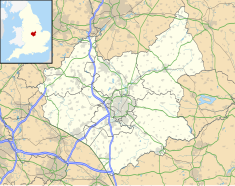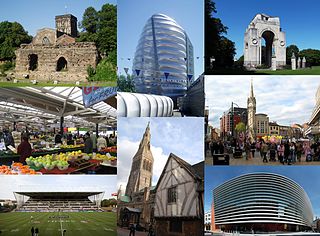
Leicester is a city, unitary authority and the county town of Leicestershire in the East Midlands of England.

Leicestershire is a ceremonial and non-metropolitan county in the East Midlands, England. The county borders Nottinghamshire to the north, Lincolnshire to the north-east, Rutland to the east, Northamptonshire to the south-east, Warwickshire to the south-west, Staffordshire to the west, and Derbyshire to the north-west. The border with most of Warwickshire is Watling Street, the modern A5 road.

Ashby-de-la-Zouch, sometimes spelt Ashby de la Zouch and shortened locally to Ashby, is a market town and civil parish in the North West Leicestershire district of Leicestershire, England. The town is near to the Derbyshire and Staffordshire borders. Its 2001 census population of 11,410 rose to 12,370 in 2011. The castle in the town was an important fort in the 15th–17th centuries. In the 19th century the town's main industries were ribbon manufacture, coal mining, and brickmaking.

The Cathedral Church of Saint Martin, Leicester, commonly known as Leicester Cathedral, is a Church of England cathedral in Leicester, England and the seat of the Bishop of Leicester. The church was elevated to a collegiate church in 1922 and made a cathedral in 1927 following the establishment of a new Diocese of Leicester in 1926.
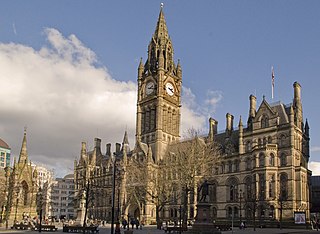
Manchester Town Hall is a Victorian, Neo-gothic municipal building in Manchester, England. It is the ceremonial headquarters of Manchester City Council and houses a number of local government departments. The building faces Albert Square to the north and St Peter's Square to the south, with Manchester Cenotaph facing its southern entrance.
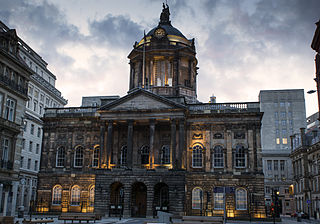
Liverpool Town Hall stands in High Street at its junction with Dale Street, Castle Street, and Water Street in Liverpool, Merseyside, England. It is recorded in the National Heritage List for England as a designated Grade I listed building, and described in the list as "one of the finest surviving 18th-century town halls". The authors of the Buildings of England series refer to its "magnificent scale", and consider it to be "probably the grandest ...suite of civic rooms in the country", and "an outstanding and complete example of late Georgian decoration".

The Haymarket Memorial Clock Tower is a major landmark and popular meeting point in Leicester, United Kingdom. It is located roughly in the middle of the area inside the ring-road, and is at the point where five major streets meet; Gallowtree Gate, Humberstone Gate (A47), Haymarket (A607), Church Gate (A6) and Eastgates (A47).

Ullesthorpe is a small village and civil parish situated in the Harborough district in southern Leicestershire. Ullesthorpe is noted for its historic background with a mill, disused railway station and traces of a medieval settlement evident on the edge of the village.

The Bath Assembly Rooms, designed by John Wood the Younger in 1769, are a set of assembly rooms located in the heart of the World Heritage City of Bath in England which are now open to the public as a visitor attraction. They are designated as a Grade I listed building.

Nottingham Council House is the city hall of Nottingham, England. The 200 feet (61 m) high dome that rises above the city is the centrepiece of the skyline and presides over the Old Market Square which is also referred to as the "City Centre". It is a Grade II* listed building.

Holkham Hall is an 18th-century country house near the village of Holkham, Norfolk, England, constructed in the Neo-Palladian style for the 1st Earl of Leicester, by the architect William Kent, aided by Lord Burlington.

The Indiana Convention Center is a major convention center located in Downtown Indianapolis, Indiana, United States. The original structure was completed in 1972 and has undergone five expansions. In total, there are 71 meeting rooms, 11 exhibit halls, and three multi-purpose ballrooms. The connected facilities of Lucas Oil Stadium offer an additional 183,000 square feet (20,000 m2) of exhibit space and 12 meeting rooms.

Hyatt Regency Seattle, also known as 808 Howell Street and 8th & Howell, is a high-rise hotel in the Denny Triangle neighborhood of Seattle, Washington that opened in December 2018. The 45-story hotel, operated by Hyatt, has 1,260 hotel rooms and is the largest in the city. It also has 103,000 square feet (9,600 m2) of meeting and event space, as well as two ballrooms and a lounge.

Buxton Crescent is a Grade-I-listed building in the town of Buxton, Derbyshire, England. Owing much to the Royal Crescent in Bath, but described by the Royal Institution of British Architects as "more richly decorated and altogether more complex". It was designed by the architect John Carr of York, and built for the 5th Duke of Devonshire between 1780 and 1789. In 2020, following a multi-year restoration and redevelopment project supported by the National Heritage Memorial Fund and Derbyshire County Council, The Crescent was reopened as a 5-star spa hotel.
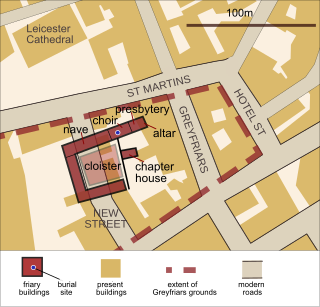
Greyfriars, Leicester, was a friary of the Order of Friars Minor, commonly known as the Franciscans, established on the west side of Leicester by 1250, and dissolved in 1538. Following dissolution the friary was demolished and the site levelled, subdivided, and developed over the following centuries. The locality has retained the name Greyfriars particularly in the streets named "Grey Friars", and the older "Friar Lane".

The Old Ship Hotel is a hotel in central Brighton, UK, which contains the Old Ship Assembly Rooms, a Grade II* listed building. The building is the oldest hotel in Brighton, as the hotel is believed to have been built in 1559, with the assembly rooms being added in 1767.

The Shire Hall is a municipal facility in Tindal Square in Chelmsford, Essex. It is a Grade II* listed building.

County Hall is a municipal building on Leicester Road in Glenfield, Leicestershire. It is the headquarters of Leicestershire County Council.

Scarborough Town Hall, originally St Nicholas House, is a red brick Jacobean Revival mansion in Scarborough, North Yorkshire, England, currently used as a municipal building for the Borough of Scarborough and an events venue. It was built in the 19th century as a home for John Woodall, a prominent local businessman, and then converted and extended for municipal use in 1903. Situated overlooking the South Bay, it is a grade II listed building.

Newark Town Hall is a municipal building consisting of a town hall, assembly rooms and a market hall in Newark on Trent, Nottinghamshire, England. It is a Grade I listed building.

